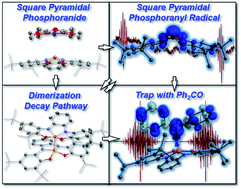Geometrically constrained square pyramidal phosphoranide†
Abstract
Geometrical constriction of main group elements leading to a change in the reactivity of these main group centers has recently become an important tool in main group chemistry. A lot of focus on using this modern method is dedicated to group 15 elements and especially to phosphorus. In this work, we present the synthesis, isolation and preliminary reactivity study of the geometrically constrained, square pyramidal (SP) phosphoranide anion (1−). Unlike, trigonal bipyramidal (TBP) phosphoranides that were shown to react as nucleophiles while their redox chemistry was not reported, 1− reacts both as a nucleophile and reductant. The chemical oxidation of 1− leads to a P–P dimer (1-1) that is formed via the dimerization of unstable SP phosphoranyl radical (1˙), an unprecedented decay pathway for phosphoranyl radicals. Reaction of 1− with benzophenone leads via a single electron transfer (SET) to 1-OK and corresponding tetraphenyl epoxide (4).

- This article is part of the themed collection: Most popular 2022 main group, inorganic and organometallic chemistry articles


 Please wait while we load your content...
Please wait while we load your content...